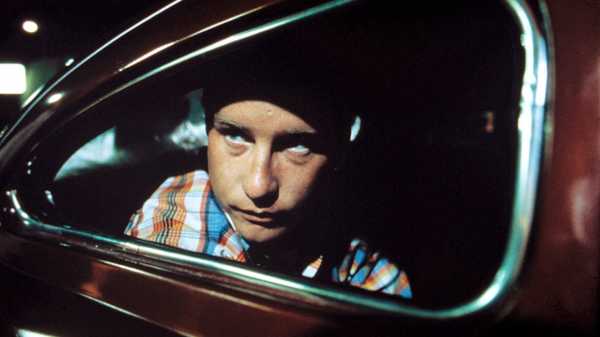
One of the main events in New York screenings this season is Film Forum’s month-long series “Far-Out in the 70s: A New Wave of Comedy, 1969–1979,” which runs from January 18th to February 14th and embraces a wide spectrum of movies, including George Lucas’s second feature, “American Graffiti,” from 1973 (and screening January 20th and 21st). It’s Lucas’s only work of first-person filmmaking, a comedic drama about his adolescence in Modesto, California, but it nonetheless fits tightly alongside the historic work of his next feature, “Star Wars.”
“American Graffiti” takes place in the course of a single night at the end of summer the summer of 1962, the day before a pair of newly minted high-school graduates, Curt (Richard Dreyfuss) and Steve (Ron Howard), are scheduled to leave their home town for an unnamed Eastern college. Curt, a slightly awkward and philosophical loner, is unsure whether he’ll actually get on the plane—he’s unsure of what he wants from life and thinks that he might stay home for a year and figure things out. Steve, the outgoing class president and the boyfriend of Curt’s sister, Laurie (Cindy Williams), the head cheerleader, is so confident in himself that he informs Laurie that, while he’s away, they should see other people—and, when she breaks up with him on the spot, he spends the rest of the movie chasing after her to patch things up.
Lucas adds some other plot lines and a busy, varied set of characters to form a heartfelt, loving series of sketches from memory. Despite its realistic intimacy and comedic warmth, though, “American Graffiti” is centered not on its characters but, rather, on its cultural artifacts. Car culture is at the core of the movie, with high-gloss hot rods serving as fetish objects and social capital—and also sparking the tense and dangerous drama of street racing that turns out to play a major role in the story. (It's also a part of the relentless regime of catcalling and pickup-aggression to which women are seen enduring.) Even more prominent throughout is the jukebox-style soundtrack of fifties and early-sixties rock-and-roll hits, punctuated by the voice of the d.j. Wolfman Jack (playing himself), who spins the records on a radio station that is the teens’ constant companion. His voice and virtual presence seemingly stage-manage their lives, and his carefully modulated choice of records directs the tones and moods of the long and crucial night.
In “American Graffiti,” Lucas mythologizes his past, rooting it in these cultural templates no less than he would build “Star Wars” on his lifelong memories of watching “Flash Gordon” serials. What’s more, just as “Star Wars” tapped into a complicated era’s longing for heroic simplicities untainted by the morality of history, so “American Graffiti” was a crucial part of the nostalgia machine that became (and remains) the engine of American mass media. (Also, Lucas signed the deal for “Star Wars” together with the one for “American Graffiti,” in 1971, as his biographer Brian Jay Jones reports.)
Like such contemporaries as Francis Ford Coppola (who produced “American Graffiti”), Martin Scorsese, Steven Spielberg, and Brian De Palma (and like their forerunners in the French New Wave, who were crucial inspirations), Lucas came to the movies with a media-made mind-set, in which personal experience was inseparable from (and even subordinate to) voracious cultural consumption. In looking back to the early sixties and its artifacts, “American Graffiti” also looked back to the pre-Vietnam War era. It was only one of many mainstream works (movies, television, even music) that pined for the prelapsarian fifties and sixties—to what, at least to the white male executives wielding the levers, looked in the rearview mirror like happy days.
“American Graffiti” was set in a context of blissful ignorance regarding political conflicts and international crises; it’s an insistently, hermetically ahistorical film. By the end, the characters’ obliviousness comes off not only as a privilege and a pleasure but a disaster: it renders them not history’s agents but (avoiding spoilers) history’s victims. The nostalgia of “American Graffiti” is bitterly ambivalent—it captures a moment when ignoring politics was an option at a moment in which something could rather have been done; its characters’ carefree and heedless indifference eventually reveals its colossally high price.
Stream “American Graffiti” on Amazon, Vudu, iTunes, and other services.
Sourse: newyorker.com






